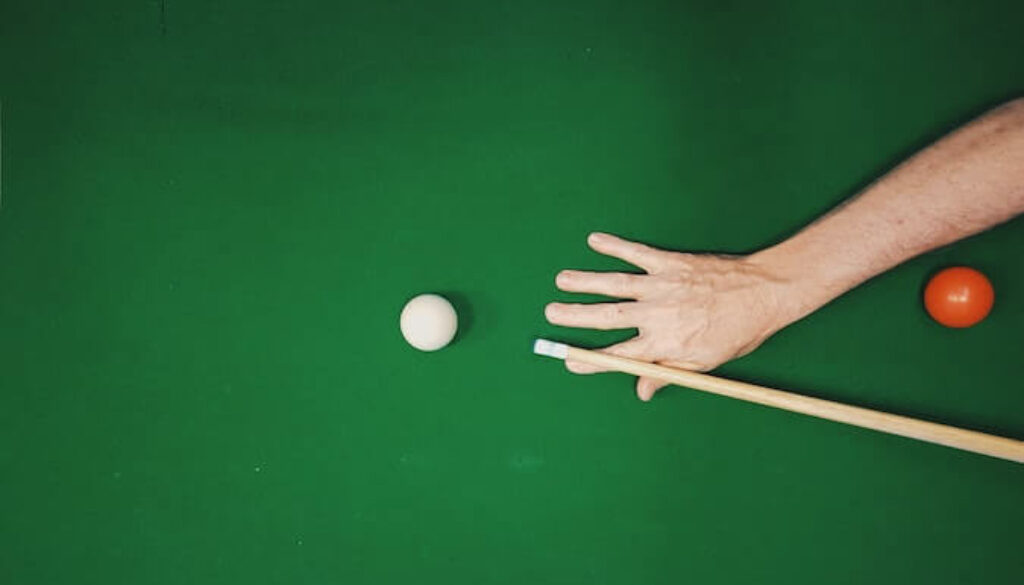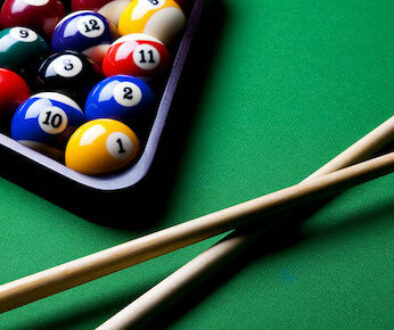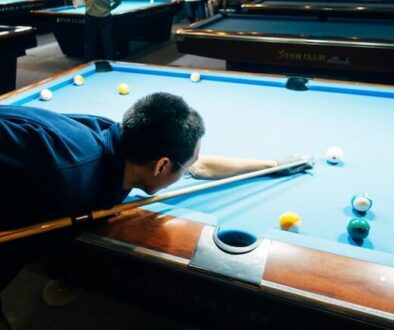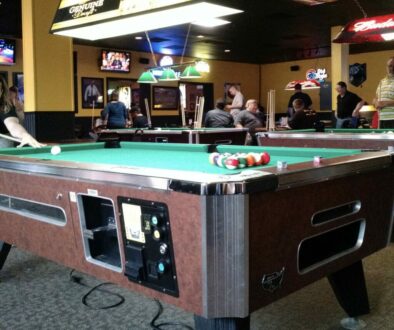Choosing the Perfect Pool Cue In 7 Easy Steps
The pool cue is the key component a pool player needs to succeed at any billiards game. Whether you play pool competitively or for fun, it’s important to be an informed buyer. This ensures that the pool cue you choose fits your preferences and your playing style.
Your choice of pool cue can potentially make or break your game, so it’s important to take all cue factors into consideration.
So, how do you know exactly what cue you need? There are many choices when it comes to buying a pool cue, which can make the decision a bit difficult. These choices can include a vast range of cue sizes, finishes, tips, shafts, materials, and more.
In this article, we aim to take the guessing out of the process and make your pool cue search a lot easier.
Choosing the Right Cue
Here are the 7 most important steps to follow when picking a pool cue.
1. Determine type of cue, and how many cues you need
You first need to figure out what type of cue you’re looking for. You need to know what to look for when shopping, and this will also help you prevent wasting time looking at products you definitely won’t buy. There are generally 2 different types of cues – break cues and regular cues.
Break Cues and Regular Cues
Break cues typically have hard phenolic tips, shorter ferrule (around ½-inch), and thicker shafts to withstand the extra force. The tips on regular playing cues are softer and allow for more spin. Also, the ferrules on playing cues are longer (almost 1 inch), and the shafts are slender, which is ideal for cue ball control and feel during shots.
Regular cues can be used for both breaking and post-break, but the break cues work best for breaking only. Many casual and beginner pool players use regular cues for their break shots and regular play. Lots of these players have never used a break cue and don’t really have the need for one.
Professional and more serious players have found that their game benefits from using a break cue. A break cue allows for more power and control for the break shots, and will leave a more open table.
A regular playing cue is enough for a beginner or casual player. But, if you play competitively or hope to play competitively, you should consider getting a break and a regular cue.
When it comes to how many cues you need, it depends on the type of player you are. Depending on the player, the number of cues they require might differ. Some players may be collectors, and some players may live more simply and minimalistic.
If you’re looking for more than one cue, you’ll likely want a break cue and a regular playing cue at the very least.
2. Determine your cue budget
You don’t have to spend a fortune to get a good pool cue. You can buy something basic for as little as $50. But, there are some expensive high-end cues made for more advanced players that will retail for upwards of $1,000 or more.
If you are a beginner, you should be ready to spend between $100 and $150 to get a decent cue. If you want a more advanced cue that has lower deflection and more premium construction, you’ll likely pay at least $200.
While beginners don’t have to pay less than $200 for a cue, we recommend doing so to avoid overpaying only to realize you don’t enjoy pool.
Additionally, your budget may depend on whether you want a custom or production pool cue.
A custom cue is made from scratch according to your specifications, and you can choose things like material, length, weight, and taper. In turn, custom cues will be more expensive. There are many custom cue makers that do amazing work.
Production cues are made according to the manufacturer’s specifications to suit specific markets or player types. These are often mass-produced, which is cheaper than making custom cues, resulting in a more affordable cue.
Production cues may not always fit your game perfectly, but you can make adjustments on your purchased pool cue, such as tip changes or switching out shafts.
3. Wood vs. carbon fiber
Next, you should decide whether you prefer a wooden or carbon fiber cue. If you are new to the game, you may have played with either type, but when it comes to recent cues, carbon fiber is probably more common.
More experienced players that have used both types will have an easier time deciding as they know how both feel and play. But if you’re new to pool, we’re here to help you get more familiar with wood and carbon fiber and understand the differences.
The main difference between wood and carbon fiber shafts is their durability. Carbon fiber is more durable than wood as it is less susceptible to weather changes and more resistant to dents and scratches. That being said, they can still scratch with regular use over time.
Most wood cues will have a softer feel than the stiffer carbon fiber material as they absorb the impact a little better. The natural wood grain is also a little more visually appealing to many people.
4. Find the perfect cue weight
Cue weight can have a massive impact on your shot. It also determines how easy the cue will be to handle, and your comfort level with the cue.
Pool cues typically weigh between 17 and 21 ounces. Most players prefer 18 to 20 ounce cues as they are heavy enough for powerful break shots and light enough for regular playing with minimal arm fatigue.
The right cue weight for you depends solely on your own personal preference.
If you’re below average in size and strength, a lighter cue may be best for you. If you’re a bigger, stronger person, a heavier cue may be your best bet. That said, there are many pool players of all shapes and sizes that play with both light and heavy cues.
It may benefit you to try out different cues to understand what weight you are most comfortable and confident with.
5. Choose cue diameter and shaft taper
You should also consider the cue diameter and shaft taper when deciding what to buy. The cue diameter determines how well the cue will fit into your bridge hand, and how much power can be loaded into your shaft at impact.
Most pool cues have a shaft diameter between 12 and 13 mm, and there are several options available. They typically come in 1/4 mm increments. Hand size is one thing that can determine what diameter will feel more comfortable, but this will also depend on personal preference.
Cue shafts with thicker diameters will pack a little more power in the shot, with less spin. They are also a little more forgiving since the tip will be contacting more surface area of the cue ball than a thinner shaft.
Skinnier shafts will add more cue ball spin and are a little less forgiving on mis-cues.
When it comes to the shaft taper, there are 2 very common types: Standard and Pro tapers.
- Standard (European) tapers will continually decrease in diameter from the butt to the tip. This taper is good for new players as it is more forgiving and provides stable shots.
- Pro taper shafts maintain an even diameter for the first 12 inches of the cue, then become wider towards the cue joint. This consistent diameter through the bridge hand ensures it will not interfere with your stroke. The pro taper is what many professional and advanced pool players prefer.
6. Pick your favorite cue designs
Any pool cue you choose also needs to be appealing to your eye. Besides playing well and adding value to your game, the design should be aesthetically pleasing.
When it comes to design, it is all about personal preferences and tastes. What appeals to you will not appeal to all other pool players.
There are some common pool cue design categories you can choose from when shopping. You can go for classic pool cues, which have a more traditional cue design (sneaky pete style), or contemporary cues, which are often more colorful and have more flashy graphics.
You could also opt for a 2-piece cue with two contrasting colors.
7. Try before you buy
The last step is to try out the cue before making the purchase. Although this is not mandatory, and sometimes it is not even possible (if buying online), it is highly recommended.
Hold the cue in your hands to get a feel of the weight. Trying out the cue allows you to get a first-hand feel of how comfortable it is, and how easy it is to handle while making shots.
Many billiards stores will have tables you can practice on, so try to take some practice shots if your local store allows it. Getting a couple full games in would be even better!
If you have a friend or playing partner who has a cue you want to try, feel free to ask. Oftentimes, the best cues can be found by just trying them out whenever you get the chance.
Wrap Up
A pool cue is the most important thing you need to play pool. With the right cue, you can make more powerful and accurate shots along with better cue ball control.
Pick your pool cues carefully, whether you are a casual, intermediate, or pro player. Don’t rush it, and take all factors into consideration.
Hopefully, with these 7 easy steps, the pool cue selection process is now a little easier for you.
Ultimately the right pool cue for you will depend on your playing level, style, and personal preferences.
But the good news is that there is something out there for everyone, and you only need to know what works best for you.
As always, Happy Shooting!




